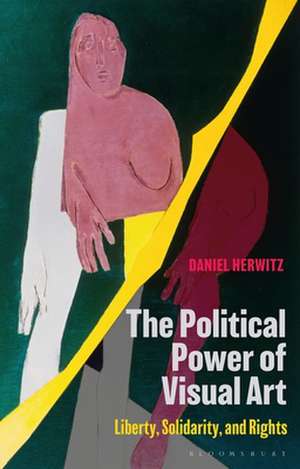The Political Power of Visual Art: Liberty, Solidarity, and Rights
Autor Daniel Herwitzen Limba Engleză Paperback – 7 apr 2021
| Toate formatele și edițiile | Preț | Express |
|---|---|---|
| Paperback (1) | 151.47 lei 3-5 săpt. | +24.30 lei 4-10 zile |
| Bloomsbury Publishing – 7 apr 2021 | 151.47 lei 3-5 săpt. | +24.30 lei 4-10 zile |
| Hardback (1) | 465.72 lei 6-8 săpt. | |
| Bloomsbury Publishing – 7 apr 2021 | 465.72 lei 6-8 săpt. |
Preț: 151.47 lei
Preț vechi: 165.31 lei
-8% Nou
Puncte Express: 227
Preț estimativ în valută:
28.98€ • 30.34$ • 23.98£
28.98€ • 30.34$ • 23.98£
Carte disponibilă
Livrare economică 17-31 martie
Livrare express 28 februarie-06 martie pentru 34.29 lei
Preluare comenzi: 021 569.72.76
Specificații
ISBN-13: 9781350182370
ISBN-10: 1350182370
Pagini: 216
Ilustrații: 10 bw illus
Dimensiuni: 138 x 216 x 20 mm
Greutate: 0.25 kg
Editura: Bloomsbury Publishing
Colecția Bloomsbury Academic
Locul publicării:London, United Kingdom
ISBN-10: 1350182370
Pagini: 216
Ilustrații: 10 bw illus
Dimensiuni: 138 x 216 x 20 mm
Greutate: 0.25 kg
Editura: Bloomsbury Publishing
Colecția Bloomsbury Academic
Locul publicării:London, United Kingdom
Caracteristici
Case studies include William Kentridge, the NEA 4 and the question of offense-as-dissent, Banksy and M.F. Husain and the Hindu nationalist Indian right wing
Notă biografică
Daniel Herwitz is Fredrick Huetwell Professor of Philosophy, History of Art and Comparative Literature at the University of Michigan, USA where for a decade he directed the Institute for the Humanities. His previously published books include Aesthetics, Arts and Politics in a Global World (2017), the award winning Star as Icon (2008), and M.F. Husain (1988).
Cuprins
1. Introduction2. Kentridge, Modisakeng and the Politics of Extraction3. David Lurie and the Politics of Visibility4. Vha-Venda, Isi-Tsonga, Democracy and Political Economy5. Gittoes, Ai Weiwei and the Politics of the Witness 6. Virulent Nationalism and the Politics of Offense7. Disgrace, Punishment, Reconciliation: Literature and the Truth Commission 8. The Personal is Political: Autonomy as Negotiation 9. Benjamin and the Politics of the Collective 10. Identity Politics in the Consumerist World 11. Artworld Politics: Manet to BanskyBibliographyIndex
Recenzii
This is a book of essays, only seemingly miscellaneous. It seeks and effectively finds a deep integration of diverse themes and movements in both art and politics, and it does so with sensibility and analytical power and an eloquence of style. How does the visual relate to dissent against the state? Can art and literature straddle both autonomy and solidarity? With what attitudes to violence is it possible to visually represent a whole empire based on the political economy of mining and a nation that comes out from under its shadow? By what gradual alchemies do philosophical traditions of taste in the eighteenth century give way to the thrusting innovations of the avant-garde some two centuries later? With what creative pride does the art and mind of the Southern periphery refuse the offer to merely play 'catch up' with the trends and frameworks of the metropolitan North? These are some of the questions Daniel Herwitz illuminatingly traverses with his wide knowledge, his lively intelligence, and his impressive cosmopolitan reach. A work of sustaining interest and instructive insight.
Uniquely and equally at home in political and formal analysis, Daniel Herwitz is at his uniform best in this book. Its breadth and subtlety of argument advance the central claim that the political achievements of art-- unlike celebrity-- increase the more it engages with the world and defers on the claim of its own importance.
Daniel Herwitz's new book is a testament to an author who can think in the present for the present. Its insight into contemporary art's contribution to the political machinations and uncertainties of our times is subtly worked through a carefully selected range of artists, critics, and philosophers. It is a model for a new philosophical art criticism that must look today beyond the staid geographical landlines of enquiry.
Uniquely and equally at home in political and formal analysis, Daniel Herwitz is at his uniform best in this book. Its breadth and subtlety of argument advance the central claim that the political achievements of art-- unlike celebrity-- increase the more it engages with the world and defers on the claim of its own importance.
Daniel Herwitz's new book is a testament to an author who can think in the present for the present. Its insight into contemporary art's contribution to the political machinations and uncertainties of our times is subtly worked through a carefully selected range of artists, critics, and philosophers. It is a model for a new philosophical art criticism that must look today beyond the staid geographical landlines of enquiry.
